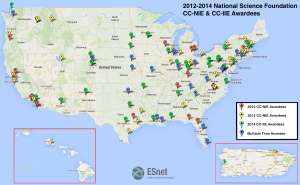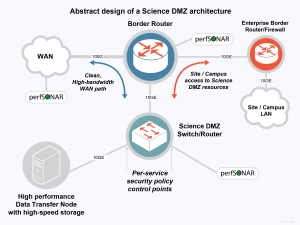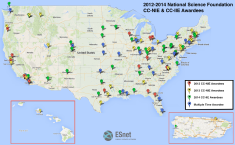From individual universities around the country to a consortium of research institutions stretching the length of the west coast, networking teams are deploying an infrastructure architecture known as the Science DMZ developed by the Department of Energy’s Energy Sciences Network (ESnet ) to help researchers make productive use of ever-increasing data flows.

This map shows the location of universities which have deployed Science DMZs or similar architectures funded by the National Science Foundation.
The Science DMZ traces its name to an element of network security architecture. Typically, located at the network perimeter, a DMZ has its own security policy because of its dedicated purpose – exchanging data with the outside world. A Science DMZ is specifically dedicated to external-facing high-performance science services.
Eli Dart, an ESnet network engineer, first coined the term “Science DMZ” in early 2010 to describe the network configuration linking two DOE sites – the Princeton Plasma Physics Laboratory in New Jersey and the National Energy Research Scientific Computing Center (NERSC) at Lawrence Berkeley National Laboratory in California. ESnet, is supported by the DOE Office of Science and provides high-bandwidth connections between 40 DOE sites in the U.S. and links to collaborators around the globe.
Dart formalized the idea in 2010 and in February 2011 took it to a broad audience at a leading conference for the international networking community.
Since then, the concept has been endorsed by the National Science Foundation (NSF), replicated at more than 100 universities, is being considered by several federal research organizations and is the basis for the new Pacific Research Platform, a cutting-edge research infrastructure which will link together the Science DMZs of dozens of West Coast research institutions. On July 30, 2015, the NSF announced it would fund a $5 million, five-year award to UC San Diego and UC Berkeley to support the Pacific Research Platform as a science-driven high-capacity data-centric “freeway system” on a large regional scale. Read more about the Science DMZ.
